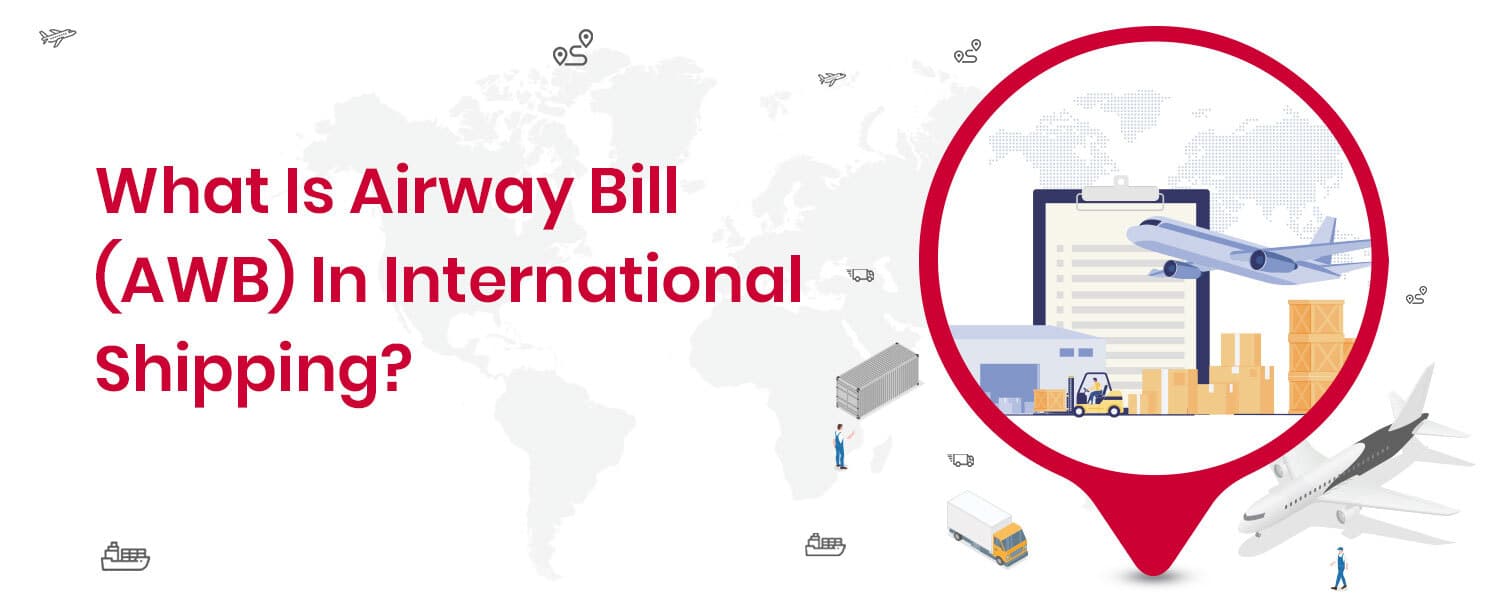Most new exporters choose air freight over ocean freight because it is quicker and less expensive. Air freight delivers goods in just 5-7 days instead of the more than eight days it takes for ocean freight to do so. If you’re consolidating shipping and your shipping costs are less than the value of the items, air freight is also advised.
Legal documentation is required for every international shipping method, including air freight. Therefore, the Airway Bill is crucial documentation for shipping airborne cargo.
What Is an Airway Bill (AWB) in International Shipping?
Any international carrier sends the Airway Bill together with the goods, which serves as a tracking mechanism for the shipment. Additionally, it serves as a contract between your carrier partner and shipper business and an airline’s evidence of airway bill receipt.
Think of the document as a consignor or sender’s receipt. An airway bill is also known as a dispatch note or consignment note. The AWB serves as proof of the contract of carriage from airport to airport and is non-negotiable. The airway bill has three mandatory parties: the sender, the airline, and the recipient.
Before any goods are shipped, the shipper must complete the airway bill. The airway bill becomes legally binding if both the shipper and the associated carrier sign it. Therefore, one must fill out the information completely and accurately because it is a legally binding instrument between the parties.
An airway bill (AWB) is a legally binding transport document that provides information about the goods being delivered and is issued by a carrier or agent. It gives thorough details about the shipment’s contents, the sender and recipient, the terms and conditions, and much more.
The AWB used to be a one-page physical paper document, but nowadays, the e-AWB, which is filled out and saved electronically, is considered the norm.
Functions of the AWB
The air waybill has a variety of uses, such as:
- Evidence of an airline receiving goods
- Information about how to reach each party
- Transport agreement between the shipper and the carrier
- Bill of Lading Customs Declaration
- Details of the products
- Advice on how to handle and distribute products
- Tracking of the delivery
Features and Format of the AWB
A typical AWB is a one-page document that is jam-packed with crucial details. The IATA created and disseminated the bill, which is used for both domestic and international shipping. The first three copies of the document—produced in eight sets of various colors—are the original.
- The copy made by the issuing carrier is the first original (green).
- The second one (pink) is a copy for the recipient.
- The shipper’s copy is on the third (blue) page.
- The fourth copy, which is brown, serves as a receipt and delivery evidence. The remaining copies are all white.
The upper right corner of the airway bill may have an airline logo, or it may be blank. Except for the airline emblem and pre-filled information for the airline, the two are nearly identical.
Each air waybill must include the carrier’s name, office address, logo, and 11-digit AWB number, which is used to make reservations and monitor the progress and location of shipments.
The airway bill document will have information for the shipper, consignee, agent, airport of departure, and airport of destination in the top-left quadrant.
The airline’s information will appear in the top-right quadrant as manually input data or printed, pre-populated text and logos. For example, the declared value for carriage and the declared value for customs will both be listed in the top-right section.
The shipment’s contents, including the number of pieces, gross weight, chargeable weight, total charge, and the type and number of items, are detailed in the middle of the page.
Additional fees and taxes, the shipper’s or agent’s signature, and a space to record the date, time, and execution location are all located at the bottom of the airway bill.
Electronic Air Waybill
On January 1, 2019, an electronic air waybill (e-AWB), first introduced in 2010, took over as the standard contract of carriage for all air freight shipments. Although paper air waybill documents are still recognized, IATA today primarily employs electronic air waybills. Therefore, the same information needed for the paper version is also communicated in the electronic version.
Each cargo shipment requires a fair amount of paper, which implies that paper needs to be tracked and distributed. Electronic document storage keeps everything safe and organized and lessens the need for paper.
Is AWB in International Shipping the same as tracking?
A tracking number is very similar to an air waybill. However, for smaller shipments or shipments that are not flying internationally, you might have a different tracking number than an air waybill since air waybills are often used for large air freight shipments with an air carrier.
What are the differences between the Airway Bill and the Bill of Lading?
The Airway Bill and the Bill of Lading are both shipping documents, but they differ in mode of transport. Airway Bill is for airfreight, detailing cargo and conditions. Bill of Lading is for ocean freight, serving as a receipt and contract.
Understanding the difference between an airway bill and a bill of lading is imperative because people always get confused about these two bills. The airway bill and the bill of lading have the same function but differ in the following ways.
Mode Of Shipping
When cargo is loaded onto a ship and transported by ocean routes, a Bill of Lading is used, but an Airway Bill (AWB) is used when the consignment is solely transported via air freight.
Legal Proof
The Bill of Lading also serves as ownership documentation for goods transported. On the other hand, the Airway Bill serves as documentation of the delivery of goods and does not attest to the ownership of the cargo.
Multiple Copies
Three originals and three copies make up the six copies of the Bill of Lading. In contrast, eight copies of the Airway Bill are available. Only the first three of these eight are genuine; the other six are copies.
What Does the AWB in International Shipping Signify?
AWB participates in shipping overseas orders in numerous ways, not just one or two.
Evidence of Delivery or Receipt
An air freight carrier issues the airway bill as official documentation that all the items listed on the shipping bill have been received. This is useful if there is a dispute about lost or stolen property.
Complete Details of Both Parties
The AWB includes information on the shipper’s and the carrier’s physical addresses, email addresses, website addresses, and phone numbers.
Declaration of Clearance for Customs
The Airway Bill is crucial for passing through customs at international borders. The paperwork indicates that the cargo was transported by air, and customs charges the appropriate taxes.
Shipment Monitoring
Each airline is assigned a unique airway bill number. Therefore, airway bill tracking is the best way to trace an international package. You may find where your shipments are by entering the airway bill number on the carrier’s website.
Safety Cover
The carrier may occasionally utilize the AWB as proof of insurance, particularly when the shipper requests security coverage.
Wrapping Up
The airway bill is further beneficial in addition to the ones listed above. Importers and exporters can use the 11-digit number on AWBs to track their goods. The transporter can only identify your merchandise once you have received an AWB problem if they have your AWB number.
Go to the tracker to keep up with the progress of your consignment. You can access the most recent information on the status of your cargo by entering your AWB number in the relevant field on the following website.
NimbusPost is a one-stop platform for all your requirements regarding shipments, management of warehouses, and more. Tracking your shipments is made easier with an advanced tracking system by NimbusPost.




